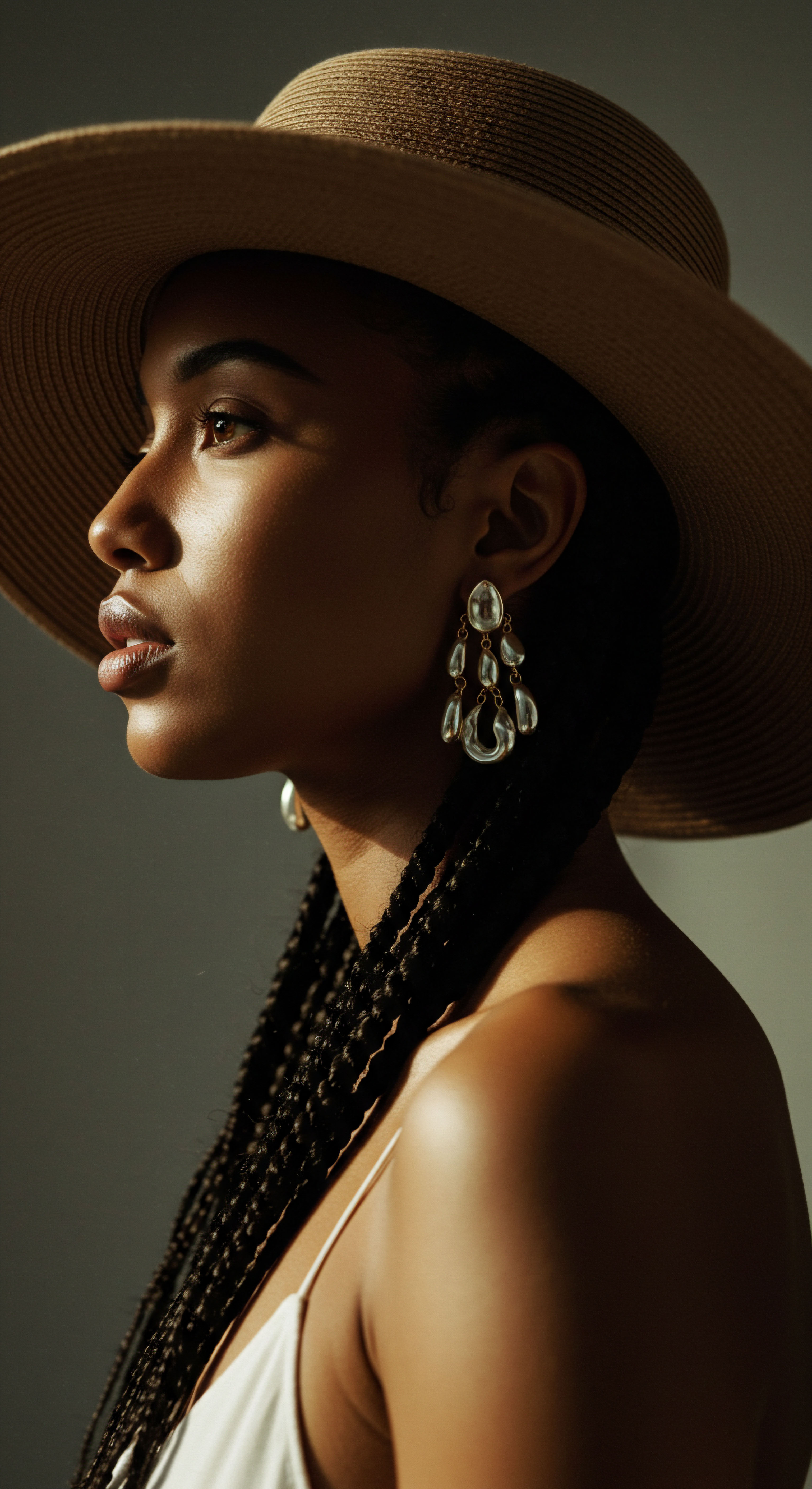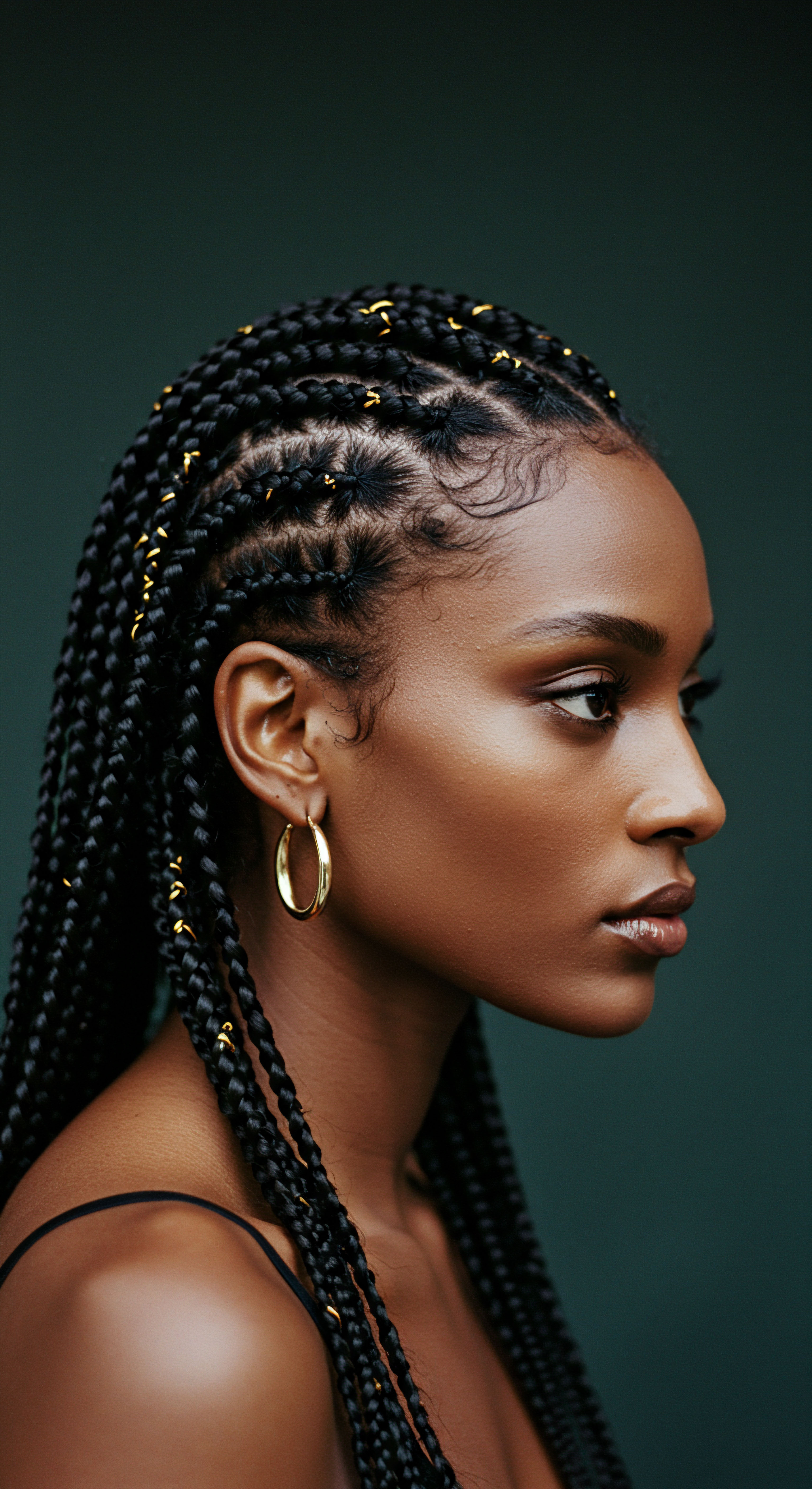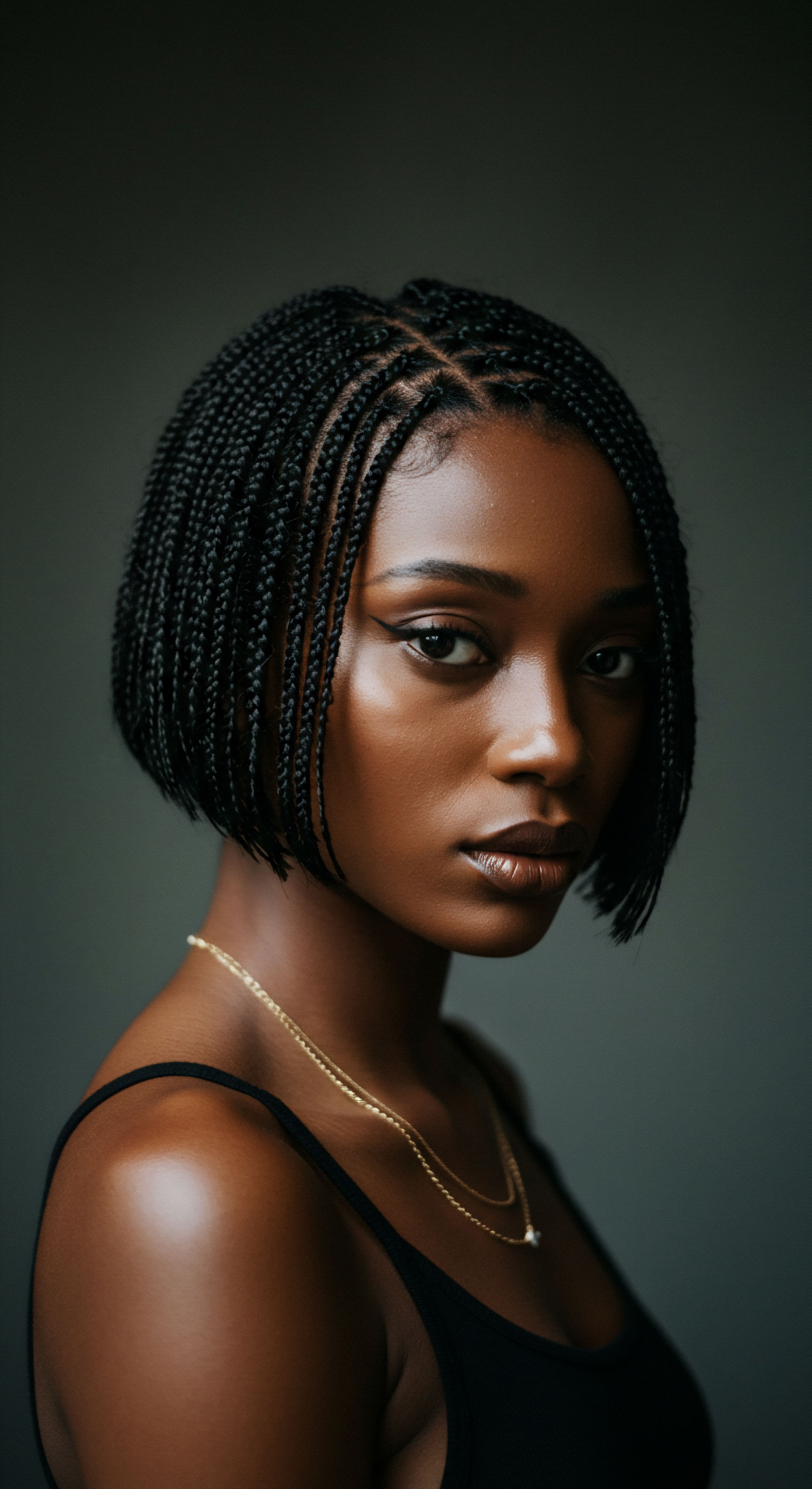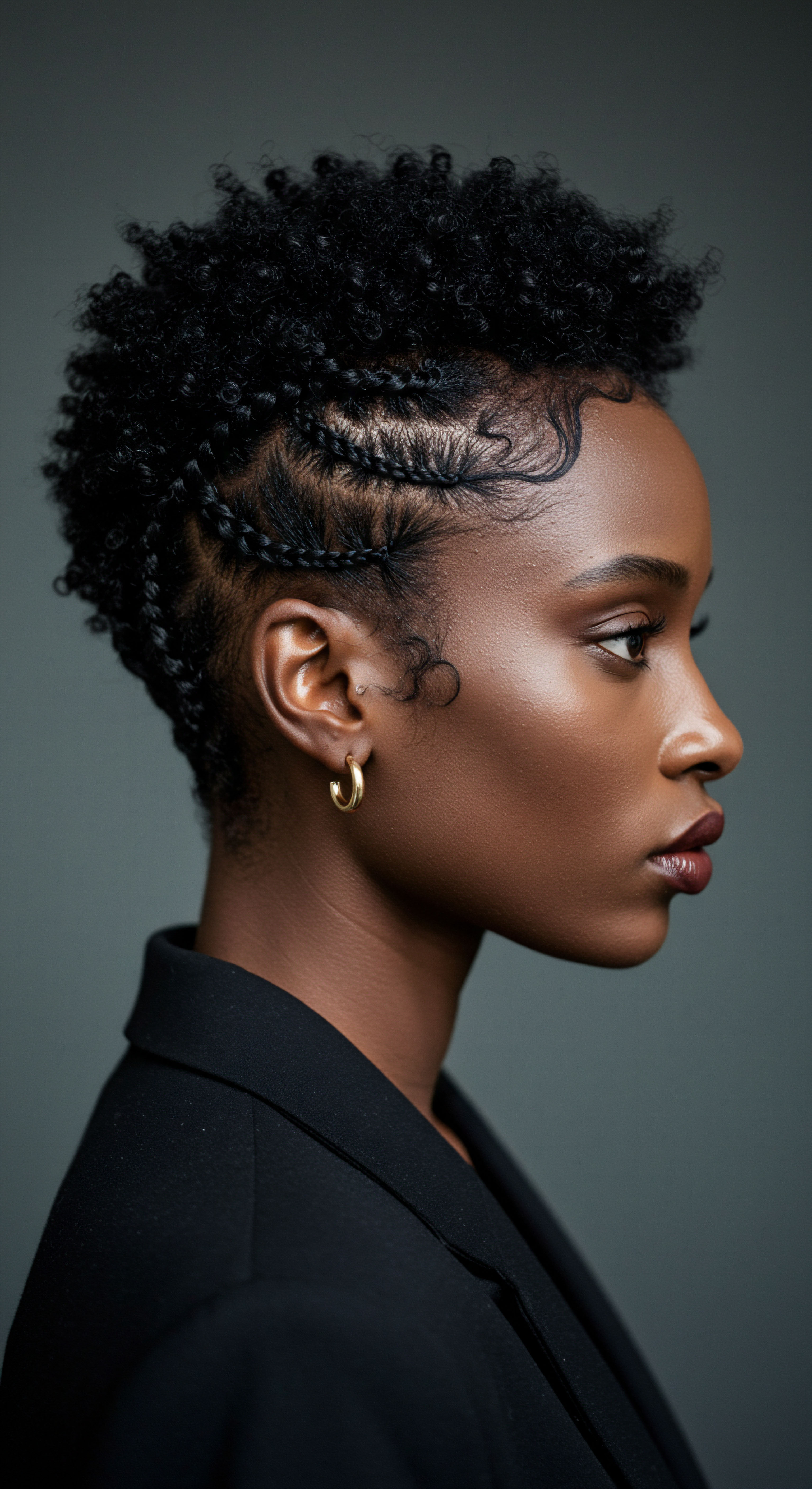
Roots
As the sun dips below the horizon, painting the sky in hues of lavender and rose, a quiet shift begins. Our bodies yearn for rest, a time of renewal and gentle surrender. For those of us who cherish textured hair, this nightly descent into slumber carries a unique conversation with our strands.
It is a dialogue between the day’s encounters and the promise of a fresh morning, a subtle negotiation between our hair’s delicate structure and the forces of friction and moisture that await in the dark. The journey of textured hair, often celebrated for its resilience and unique coils, demands a tender guardianship, especially when the world sleeps.
To truly understand the nightly needs of textured hair, one must journey within, to the very core of each strand. The architecture of hair, a marvel of natural design, speaks volumes about its vulnerabilities. Every hair shaft, a slender column rising from the scalp, consists of three primary layers, each playing a role in its strength and suppleness. The innermost, often absent in finer hair, is the Medulla, a soft, central core.
Encircling this is the Cortex, the heart of the strand, responsible for its elasticity, strength, and color. It is here that the keratin proteins, arranged in intricate helical structures, determine the hair’s curl pattern. The outermost layer, the hair’s protective shield, is the Cuticle. Picture it as a series of overlapping scales, much like shingles on a roof, all facing downwards towards the hair’s end.
When these scales lie flat and smooth, the hair possesses a natural sheen and feels soft to the touch, reflecting light with grace. However, for textured hair, the inherent curvature of the strand means these cuticle scales do not always lie as uniformly flat as they might on straight hair. This natural characteristic, while contributing to the hair’s distinct beauty, also presents specific challenges.
The very geometry of textured hair, from its elliptical cross-section to its spiraling coils, means it is more prone to the lifting of these protective cuticle scales. This gentle opening, a natural aspect of its form, can unfortunately pave the way for moisture to escape more readily. During our hours of repose, as we shift and turn, even the softest pillowcase can become a source of subtle, yet persistent, mechanical stress. This seemingly harmless contact generates friction, which, over time, can cause those delicate cuticle scales to lift further, fray, or even chip away.
The result? A diminished ability to retain vital hydration, leading to dryness, tangling, and a compromised surface that feels less smooth and appears less lustrous. It is a quiet battle waged each night, one that can subtly undermine the day’s diligent care if left unattended.
Consider the delicate balance of hydration within each strand. Textured hair, by its very nature, tends to possess lower internal hydration levels compared to other hair types, making it more susceptible to dryness. This inherent thirst is compounded by environmental factors and daily manipulation. When we sleep, particularly on absorbent materials like cotton, moisture can be drawn away from the hair, exacerbating this natural tendency towards dehydration.
The hair, already seeking a delicate moisture balance, becomes further parched, leading to a cascade of effects ❉ reduced elasticity, increased brittleness, and a greater propensity for breakage. Understanding this foundational aspect of textured hair’s physiology is the initial step towards truly protecting it overnight, transforming a potential vulnerability into an opportunity for restorative care.
The unique structure of textured hair, with its naturally lifted cuticles and lower inherent moisture, renders it particularly vulnerable to overnight friction and dehydration.

Why Hair Seeks Shelter at Night
The reasons behind our hair’s nightly need for shelter are deeply rooted in both its biological makeup and the physical realities of sleep. Each toss and turn, each gentle brush against a pillow, contributes to a cumulative effect that can chip away at the hair’s integrity. The mechanical stress exerted on the hair during sleep is a silent adversary, working tirelessly to disrupt the delicate alignment of cuticle scales. This disruption does not merely affect appearance; it compromises the hair’s ability to defend itself against external elements, making it more prone to tangling and environmental damage during the day.
Moreover, the phenomenon of moisture exchange during sleep cannot be overstated. Our bodies naturally release moisture, and pillowcases made from absorbent materials can act like tiny sponges, drawing hydration from our hair. This is particularly concerning for textured hair, which, as noted, already leans towards dryness. The consistent removal of moisture, night after night, can lead to a state of chronic dehydration, leaving strands feeling rough, looking dull, and becoming significantly more fragile.
This moisture depletion also impacts the hair’s natural elasticity, its ability to stretch and return to its original form without snapping. When hair loses its suppleness, it becomes stiff and brittle, easily breaking under even minimal tension, such as during morning detangling.
Beyond the physical, there is a subtle energetic cost to unprotected sleep. The constant friction can generate static electricity, causing strands to repel each other, leading to increased frizz and a less defined curl pattern upon waking. This ‘bed head’ effect is more than just an aesthetic inconvenience; it is a signal of disturbed cuticles and compromised moisture. By consciously providing a protective environment for our hair as we sleep, we are not simply preserving a hairstyle; we are upholding the very health and vitality of each strand, allowing it to rest and rejuvenate, ready to greet the new day with its natural strength and grace.
- Cuticle Integrity ❉ The outermost layer, composed of overlapping scales, acts as a protective barrier. Friction during sleep can lift these scales, compromising the hair’s defense.
- Moisture Retention ❉ Textured hair naturally possesses lower hydration levels. Absorbent pillowcases can draw out existing moisture, leading to dryness and brittleness.
- Mechanical Stress ❉ Tossing and turning creates tension and pulling, which can weaken strands and contribute to breakage, especially at the hair’s weaker points.

Ritual
Stepping into the realm of nighttime hair care for textured strands is akin to entering a sacred space, where mindful action meets gentle intention. It is a daily practice, a soothing ritual that transforms the vulnerable hours of sleep into a period of deep nourishment and steadfast protection. This approach acknowledges that our hair, like a delicate plant, thrives when given the right conditions to rest and restore.
The aim here is not merely to preserve a style, but to actively support the hair’s health, ensuring it wakes renewed, vibrant, and ready for the day’s unfolding. It is a quiet conversation with our curls, coils, and waves, a promise of care whispered before dreams take hold.
The wisdom of protective styling, passed down through generations and refined by contemporary understanding, offers a gentle shield against the rigors of night. These styles are not simply aesthetic choices; they are thoughtful constructions designed to minimize friction, reduce tangling, and seal in precious moisture. By securing the hair in specific configurations, we lessen its direct contact with abrasive surfaces and prevent individual strands from rubbing against each other, which is a primary cause of cuticle damage and frizz.
The effectiveness of these methods lies in their simplicity and their profound respect for the hair’s natural state. Each style, a silent guardian, works while we rest, allowing our hair to maintain its integrity and definition, rather than succumbing to the disarray of morning.

Which Styles Offer Overnight Care?
A spectrum of styles offers refuge for textured hair during sleep, each tailored to different lengths, densities, and desired morning outcomes. The common thread among them is their ability to gather and secure the hair, creating a cohesive unit that moves with less resistance and retains moisture more effectively. Choosing the right style often involves a gentle consideration of what your hair needs most ❉ deep hydration, curl preservation, or simply a smooth, tangle-free awakening.
The Pineapple Method, a favorite for those with looser curls or medium-length textured hair, involves gathering all the hair into a very loose, high ponytail at the crown of the head. This elevated position minimizes contact between the hair and the pillow, allowing curls to remain largely undisturbed and preventing them from being flattened or crushed. A soft satin or silk scrunchie, chosen for its smooth surface, secures the hair without creating tension or leaving an indentation. This method is particularly adept at preserving curl definition and volume at the roots, making for an easier refresh in the morning.
For more compact curls or longer lengths, Braids and Twists stand as stalwart protectors. Loose braids, whether a single large braid or several smaller ones, enclose the hair, significantly reducing friction and preventing tangles. Similarly, two-strand twists or flat twists offer a gentle containment, keeping strands aligned and protected. The key here is to ensure these styles are not pulled too tightly at the scalp, as excessive tension can cause strain on the hair follicles.
These styles also offer a delightful bonus ❉ when unraveled in the morning, they can reveal elongated, defined waves or curls, providing a versatile foundation for daytime styling. The very act of sectioning and twisting or braiding the hair before bed becomes a meditative moment, a quiet acknowledgment of care.
Bantu Knots, a style with deep cultural roots, also serve as an exceptional overnight protector, particularly for those seeking heightened curl definition or a stretched look without heat. Small sections of hair are twisted and coiled tightly against the scalp, forming compact knots. This method not only safeguards the hair from friction but also encourages a uniform curl pattern to set as the hair dries.
Upon unraveling, the hair reveals bouncy, well-formed spirals. The choice of style often depends on the desired morning aesthetic and the specific needs of the hair on a given night, but each option offers a profound commitment to preserving hair health.
Protective styles like pineapples, loose braids, and gentle twists offer a shield against overnight friction and moisture loss, maintaining hair integrity.

The Unsung Heroes of Nighttime Protection
Beyond the styles themselves, certain accessories play a silent, yet significant, role in amplifying the protective benefits of nighttime routines. These unassuming items act as crucial intermediaries between your hair and the world of your slumber, ensuring that the care you pour into your strands during the day continues uninterrupted through the night.
The paramount guardians in this nightly vigil are materials that offer minimal friction and do not absorb moisture. Silk and Satin reign supreme in this regard. Unlike cotton, which possesses a more abrasive surface and a thirsty nature, silk and satin allow hair to glide smoothly across their surface, significantly reducing the mechanical stress that leads to frizz, tangles, and breakage. A cotton pillowcase, even one with a high thread count, can act like a gentle sandpaper on the delicate cuticle layers, especially for textured hair which already has a naturally more open cuticle structure.
Silk and satin, conversely, create a smooth glide, allowing the hair to retain its natural oils and moisture, which is vital for maintaining elasticity and preventing dryness. This distinction is not merely anecdotal; it is grounded in the physical properties of the fibers themselves.
Consider the choices:
- Satin or Silk Pillowcases ❉ These are often the first line of defense, transforming any sleeping surface into a sanctuary for your hair. They reduce friction as you shift, preserving curl patterns and minimizing breakage.
- Hair Bonnets ❉ A satin-lined bonnet provides an enclosed, protected environment for your entire head of hair. It keeps all strands contained, preventing them from rubbing against the pillow or each other. This is especially beneficial for those with voluminous styles or very delicate strands, offering comprehensive coverage.
- Silk or Satin Scarves ❉ For those who prefer a customizable wrap, a silk or satin scarf offers versatility. It can be tied in various ways to secure different styles, from simple wraps to elaborate turban-like coverings, providing a personalized level of protection.
The continuous usage of these gentle materials contributes meaningfully to the long-term health of textured hair. They work in tandem with protective styles to create an optimal environment for hair preservation, minimizing the daily need for excessive manipulation or product application to counteract overnight damage. This thoughtful selection of nighttime accessories transforms sleep from a potential source of stress for your hair into a restorative period, where strands can truly rest and recuperate.

Relay
How does the very structure of our hair, and the gentle touch of the night, speak to a deeper understanding of its care? To truly appreciate the power of protective styles, we must move beyond simple observation and delve into the scientific whispers that underpin our daily rituals. The relationship between textured hair and its nocturnal environment is not a mere convenience; it is a complex interplay of physics, biology, and even cultural resonance, all contributing to the vitality of our strands. This inquiry invites us to consider how seemingly small choices, like a nightly braid or a silk covering, hold profound implications for the long-term health and resilience of our hair.
The inherent architecture of textured hair presents a unique mechanical challenge. Unlike straight hair, which tends to have a more circular cross-section and a relatively uniform cuticle layer, textured hair often exhibits an Elliptical Cross-Section and a helical growth pattern. This spiraling form, while creating captivating curls and coils, also means that the hair shaft bends and twists upon itself. At these points of curvature, the cuticle scales are naturally more lifted and exposed.
This anatomical reality means textured hair is inherently more susceptible to mechanical damage than straight hair. The very beauty of its curl makes it a little more vulnerable to external forces. Consider the microscopic view ❉ where straight hair might glide, textured hair’s natural bends create more points of contact and therefore more opportunities for friction, especially when subjected to the repetitive movements of sleep.
The human body, in its natural rhythm, shifts position approximately 40 times each night. Each subtle movement, each gentle turn of the head, creates a measurable amount of friction between the hair and the sleeping surface. For textured hair, where the cuticle scales are already poised for interaction due to the hair’s coiled nature, this nightly friction translates into a consistent, low-level abrasion. This abrasion can cause the cuticle scales to lift further, fray, or even chip away, exposing the delicate cortex beneath.
When the cortex is exposed, the hair loses its ability to retain moisture efficiently, leading to dryness, brittleness, and an increased likelihood of breakage. This is a quiet, continuous process, often unnoticed until the cumulative effects manifest as dullness, frizz, and weakened strands. The scientific recognition of this heightened susceptibility underscores the absolute importance of mitigating friction during sleep.
The unique helical shape and elliptical cross-section of textured hair make it inherently more prone to mechanical damage from sleep-induced friction.

How Do Materials Influence Hair Health Overnight?
The choice of sleeping surface or hair covering plays a significant role in minimizing this mechanical stress and preserving the hair’s delicate balance. Materials like cotton, despite their softness, possess microscopic fibers that create friction and absorb moisture. In contrast, silk and satin, with their smooth, tightly woven surfaces, allow hair to glide without resistance. This reduced friction is not merely a comfort; it is a scientifically observable phenomenon that directly impacts cuticle integrity and moisture retention.
Research indicates that silk absorbs less moisture than cotton, allowing the hair and skin to retain their natural hydration. This is particularly beneficial for textured hair, which, as noted, often struggles with maintaining adequate moisture levels. By creating an environment where hair can maintain its hydration, we directly support its elasticity and reduce its propensity for breakage.
| Material Type Cotton |
| Friction Level High |
| Moisture Absorption High |
| Impact on Cuticle Increased lifting, fraying, damage |
| Overall Hair Health Effect Increased dryness, frizz, breakage |
| Material Type Silk/Satin |
| Friction Level Low |
| Moisture Absorption Low |
| Impact on Cuticle Minimized disturbance, preservation |
| Overall Hair Health Effect Improved hydration, reduced frizz, enhanced strength |
| Material Type This table illustrates the fundamental differences in how common sleep materials interact with textured hair. |
Furthermore, the pH balance of hair products, even those used during the day, can influence how hair responds to nighttime conditions. A study from Brazilian researchers in 2014 found that alkaline pH in shampoos can increase negative electrical charges on the hair surface, leading to increased friction and static electricity, and ultimately cuticle damage and breakage. This highlights a broader point ❉ the holistic approach to hair care, including product selection, contributes to the hair’s resilience against daily and nightly stressors. When hair is already compromised by an alkaline environment, it becomes even more susceptible to the mechanical forces of sleep, creating a cycle of damage that is challenging to interrupt without intentional intervention.

What Are the Long-Term Benefits of Nighttime Hair Care?
The consistent application of protective styles and the use of appropriate materials yield substantial long-term benefits for textured hair. Beyond the immediate satisfaction of waking with well-preserved curls, these practices contribute to the structural integrity and overall health of the hair shaft. Reduced friction means fewer lifted cuticles, which in turn means better moisture retention. This consistent hydration directly supports the hair’s Elasticity, its ability to stretch and return to its original state without snapping.
Hair that is well-hydrated and elastic is more resilient, less prone to breakage, and better equipped to withstand daily manipulation and environmental exposure. This proactive approach to care helps to prevent the progressive deterioration of the hair shaft, which can otherwise lead to thinning, split ends, and a dull appearance over time.
Moreover, the practice of protective styling and covering the hair at night holds deep cultural significance for many individuals with textured hair, particularly within Black communities. This tradition, passed down through generations, transcends mere aesthetics; it is an act of self-preservation, a celebration of heritage, and a practical response to the unique needs of textured strands. Historically, hair wrapping served multiple purposes, from protecting styles for factory workers during wartime to preserving moisture in climates that naturally dry hair. This continuity of practice speaks to an intuitive understanding of hair biology long before scientific studies formalized the observations.
The ritual itself provides a sense of grounding, a moment of intentional care that extends beyond the physical, fostering a connection to ancestral wisdom and a deeper appreciation for one’s natural beauty. It is a quiet rebellion against societal pressures that have often dismissed or misunderstood textured hair, reaffirming its value and demanding its rightful care.
The commitment to nightly protection also minimizes the need for excessive manipulation or heat styling in the morning. When curls are preserved and tangles are reduced, the time and effort required for daily styling diminish significantly. This reduction in manipulation directly translates to less stress on the hair shaft, fewer instances of mechanical breakage, and a greater opportunity for the hair to thrive in its natural state.
The cumulative effect of consistent, gentle care fosters a stronger, healthier head of hair, allowing its inherent beauty to shine through with less intervention and more natural radiance. This quiet dedication to nightly protection is a profound investment in the long-term vitality of textured hair, ensuring its enduring strength and captivating presence.

Reflection
As the quiet hours of night offer respite, the deliberate care of textured hair transforms into a gentle affirmation. It is a recognition of the hair’s inherent strength and its subtle vulnerabilities, a dialogue between the rhythms of nature and the wisdom of mindful practice. The styles chosen, the fabrics embraced, each element contributes to a harmonious balance, allowing our strands to rest and rejuvenate.
This nightly ritual, rooted in understanding and respect, fosters a profound connection to our hair’s journey, celebrating its resilience and ensuring its radiant continuation. It is a quiet promise kept, a testament to the enduring beauty of intentional care, woven into the very fabric of our being.

References
- Schwartz, E. & Knowles, M. (1963). Frictional Effects in Human Hair. Journal of the Society of Cosmetic Chemists, 14, 465-475.
- Bhushan, B. et al. (2014). Friction Dynamics of Straight, Curly, and Wavy Hair. Journal of the Mechanical Behavior of Biomedical Materials, 30, 227-238.
- Daniels, G. N. (2020). Comparing Protective Pre-treatments for African Hair. Cosmetic Science Research Group, University of the Arts London.
- Davis-Sivasothy, A. (2011). The Science of Black Hair ❉ A Comprehensive Guide to Textured Hair.
- Gasparin, R. M. Lourenço, C. B. & Leonardi, G. R. (2025). Porosity and Resistance of Textured Hair ❉ Assessing Chemical and Physical Damage Under Consumer-Relevant Conditions. MDPI.
- Gaines, M. et al. (2023). Accounts of Chemical Research.
- Giacomoni, P. U. & Maibach, H. I. (Eds.). (2018). Hair and Hair Diseases. CRC Press.
- Robbins, C. R. (2012). Chemical and Physical Behavior of Human Hair. Springer.
- Marsh, J. M. & Johnson, D. (2023). Assessing Hair Concerns and Physical Activity Measures Among African American Women ❉ a Mixed-Method Exploratory Study. Journal of Racial and Ethnic Health Disparities, 10(1), 147-159.
- Trueb, R. M. (2008). The Value of Hair in Health and Disease. Karger Medical and Scientific Publishers.
- Wester, R. C. & Maibach, H. I. (Eds.). (2005). Dermatotoxicology. CRC Press.
- Gueniche, A. et al. (2014). Hair Damage Induced by Oxidative Treatments ❉ Impact on Hair Mechanical Properties and Cuticle Integrity. Journal of Cosmetic Science, 65(3), 191-204.